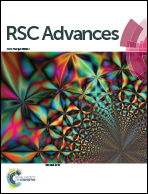Thermoelectric properties of the chalcopyrite Cu1−xMxFeS2−y series (M = Mn, Co, Ni)
Abstract
The natural chalcopyrite mineral CuFeS2 is a semiconductor material with potential for thermoelectric applications. This study presents the thermoelectric properties – electrical resistivity ρ, Seebeck coefficient S and thermal conductivity κ – of the substituted on the Cu site and/or sulfur deficient CuFeS2 chalcopyrite based series Cu1−xMxFeS2−y (M = Mn, Co, Ni, x ≤ 0.05 and y ≤ 0.02). All samples have been densified by spark plasma sintering, allowing proper measurements of S, ρ and κ at high temperature. All compounds show n-type semiconducting properties with large absolute values of S, from −220 to −340 μV K−1. Maximum ZT values up to 0.20 at 623 K were obtained for Cu0.97Mn0.03FeS2 and Cu0.98Co0.02FeS1.98. The veracity of Mn for Cu substitution into the structure has been confirmed by EDS analyses, coupled to electron diffraction within a transmission electron microscope. The latter study demonstrates the existence of twinned domains. The thermal conductivity reaches values as low as κ ∼ 1.2 W m−1 K−1 at 623 K. The magnetic properties of a Mn substituted sample did not show any significant modification in the magnetic behavior compared to the pristine CuFeS2 compound. The small negative magnetoresistance observed in CuFeS2 of about −2% at 5 K in 9 T is degraded in the Mn substituted sample.



 Please wait while we load your content...
Please wait while we load your content...